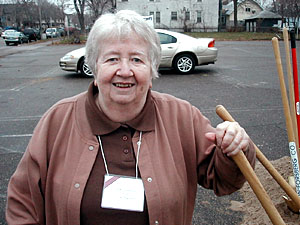|
Audio
Photos
Resources
Your Voice
|
South Minneapolis 'wasteland' sprouts new development
November 17, 2004
 |
| Hope Community fundraiser Char Madigan says investing in people stabilizes a community. (MPR photo/Dan Olson) |
Minneapolis, Minn. — There were plenty of down moments for Char Madigan and the other women who started the Hope Community in south Minneapolis 33 years ago.
One of the most discouraging came in the late l980s. Sellers of a new illicit drug called crack cocaine popped up on neighborhood sidewalks. Madigan says she and the others tried to shame the sellers.
"First we got posters that said, 'Up with hope and down with dope,' and we'd march up and down the street, and the dealers would march with us and they've got another poster, 'Up with dope and down with hope.'" she says.
 | |||
Madigan remembers the temporary shelter offered to poor women and their children by the Hope Community was essential, but little more than a band-aid.
"What we offered was a month, a little oasis, a little sanctuary. What people needed was their own place," says Madigan. "What has come to be down these years now -- 90 units of housing, and another couple hundred going up in the next few years -- it's affordable."
The turnaround in Phillips is dramatic and hardwon. The neighborhood began emptying out 35 years ago, with white flight to the new suburbs. Property values plummeted. Once the city's wealthiest neighborhood, home to grain traders, timber barons and their employees, Phillips became the poorest.
Central Community Housing Trust executive director Alan Arthur says his group signed on with the Hope Community in an effort to be a part of rebuilding the neighborhood.
 | |||
"Unfortunately, for quite a few years -- maybe more than 20 years at least -- this intersection has kind of been symbolic of much of what's wrong with our community, undercapitalized areas, etc.," says Arthur. "It's kind of a wasteland where a lot of crime, drugs and other bad things happened."
Signs of the turnaround appeared a decade ago. Neighbors pressured city officials and police to help combat crime. At the same time, downtown living became trendy. Empty-nesters and young professionals flocked to lofts and condos.
The ripple effect is being felt in Phillips. Crumbling houses and vacant lots are being bulldozed for new construction. Abandoned apartment buildings are being gutted and refurbished.
Marquise Brown, 14, and other young people in the neighborhood painted a mural that will adorn one of the new housing projects. He says he and his family arrived in the neighborhood from Memphis a few years ago.
"I just thought it was amazing that I got to experience this group of people to come together and help a community. I never seen people that cared so much about a community that Hope Community did," Brown says.
 | |||
The newest housing is being built by Hope Community and Central Community Housing Trust at the intersection of Portland and Franklin Aves. They and 10 other agencies, private and public, are funding the $8.7 million phase two of 41 units. Three more phases are planned.
Nargis Farrook, 15, her three brothers and mother moved into an apartment in phase one a few years ago. The Farrook family is from Kabul, Afghanistan. After the father and husband died, the family lived in Pakistan for seven years. Nargis says after arriving in this country they stayed in shelters, and were happy to finally find a permanent home in one of the Gateway project apartments.
"Our lives became very easy because everything surrounded you and it's a very safe place. We just love it," she says.
Many of the current residents have jobs. Hope Community's Char Madigan says they earn little more than minimum wage. Before the affordable housing supplied by the Franklin Portland Gateway project was built, the families were spending more than half their income on rent. Madigan's philosophy boils down to people who work shouldn't be poor. She says society has to change its attitude about how to help families.
"If a company pays a minimum wage, who is on welfare ... is a question that really needs to get turned around. And it's not like companies need to get blamed, because little companies can't do all this," says Madigan. "But some system then, some way of subsidizing -- I don't know if it's national health, I don't know what it is. But instead of blaming the person who can't get a living wage job, somehow the systems have to change."
The second phase of the Gateway development is named The Jourdain in honor of the late Winnie Jourdain, a former White Earth Reservation resident whose nearby home became a shelter for American Indians.
|
News Headlines
|
Related Subjects
|
